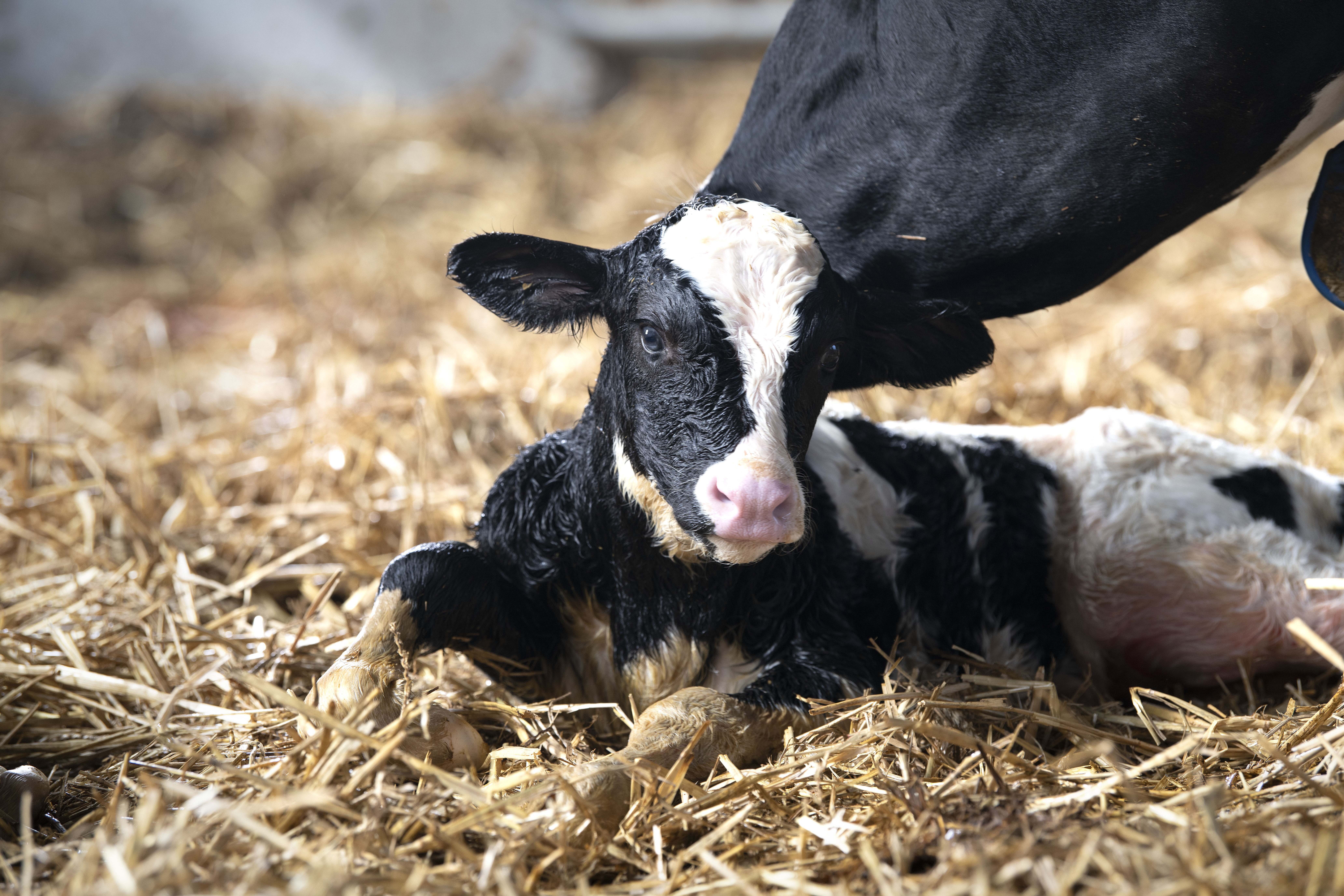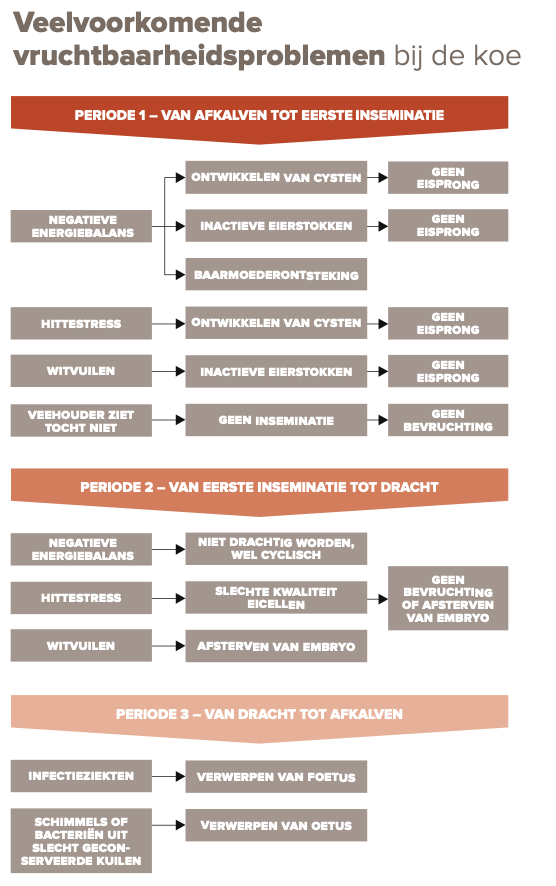Fertility problems are common in cows. The cow does not get pregnant, or embryonic or foetal death occurs. As a livestock farmer you want to prevent this. To ensure that the pregnancy goes well, according to Judith Roelofs, researcher and university lecturer on the livestock farming course at HAS Green Academy, it is important to recognise common fertility problems in the cow, allowing these to be treated on time, or even prevented.
Tense initial period
Roelofs divides fertility problems in cows into three phases: from calving to the first insemination, from the first insemination to pregnancy and from pregnancy to calving (see infographic). According to Roelofs, most problems occur during the initial two phases.
Fertility problems during the first phase, from calving to the first insemination, can be divided into two groups: the cow doesn’t go into heat, or the cow goes into heat but the livestock farmer fails to notice this. “It is important to find out first of all where the problem lies and, to this end, the vet can perform a rectal examination. If a yellow body has formed on the cow’s ovaries, she has ovulated and the farmer therefore failed to notice she was in heat,” Roelofs explains.
If a cow doesn’t go into heat, this can be for a number of reasons. “The most common reasons are ovarian cysts and inactive ovaries”, says Roelofs.
If there are ovarian cysts, the follicle – in which an egg can mature – does not burst open, therefore no ovulation takes place. The follicle remains on the ovaries, therefore the sperm are unable to reach the egg and fertilisation cannot take place.
“Cows not showing signs of heat may have ovarian cysts”, Roelofs explains. “Around 80 percent of cows with ovarian cysts show no signs of heat.” An ovarian cyst can best be diagnosed by an ultrasound performed by a vet. “An ultrasound clearly shows whether there is an ovarian cyst and whether the cyst is follicular or luteal”, says Roelofs. This is important as treatment depends on that diagnosis. If it is a follicular cyst, the follicle can be evacuated or the cow can be treated with hormones. This would restart the cycle. The hormones cause the follicle to burst open, or convert it into a yellow body and the cow will return to its cycle. If the cyst is luteal, the cow is injected with hormones to bring her into heat.
Ovarian cysts are common. ”Twenty percent of cows have developed ovarian cysts at some point”, says Roelofs. She recommends that all cows are scanned at around 21 days after calving to check on the cleaning of the uterus. “The earlier you start with scanning, the more cysts you see on the ovary. Many of these cysts simply disappear. If you know which cows have ovarian cysts, you can keep an eye on them and re-scan them on day 35. If the cysts are still present, you can start treatment,” Roelofs explains.
Eliminating causes
According to Roelofs, it is better to prevent cysts. They can result from heat stress and a negative energy balance. By focussing on a good condition score, a negative energy balance can be avoided. Roelofs: “If during the first two months after calving the cow’s condition score reduces by more than one point, this will have an enormous impact on the cow’s fertility and, among other things, on the development of an ovarian cyst. The fatter the cow, the worse the problems.”
According to Roelofs, remaining in a good condition is dependent on good management around the time of calving, such as sufficient feed, space at the feed fence and lying areas. “During late lactation, you must already ensure that the cow isn’t too fat when entering the dry period. After calving, a cow will always enter a state of negative energy balance. The trick is not to allow a negative energy balance to become too profound or to carry on for too long,” says Roelofs.
In addition, a negative energy balance can cause inactive ovaries. If a cow experiences a period of negative energy balance for too long or if it is too profound, no activity of the ovaries takes place. A follicle does not grow and an egg isn’t released, therefore the cow cannot be fertilised.
Another cause of inactive ovaries may be a chronic inflammation of the uterus – also known as endometritis. This is an infection of the uterus as a result of bacterial contamination. “When she has an inflammation of the uterus, the cow is usually not ill. She will sometimes suffer from a slightly thin and purulent vaginal discharge from the uterus,” says Judith Roelofs. To treat endometritis, the cow can be injected with hormones to bring her into heat if a yellow body hasn’t formed on the ovaries. This will make the uterus contract, eliminating the contamination and the uterus will become clean again. A livestock farmer can prevent endometritis by ensuring that the cow calves in a hygienic environment and that the cow has a good immune system. “After calving every cow will have an infected uterus. You can’t avoid that. If a cow is healthy and the environment is clean, the cow can clear up this infection herself. If the cow has a poor immune system, or if she calves in an unhygienic area, the cow will find it more difficult to clear up the infection and there is an increased risk of endometritis occurring,” Roelofs explains.
Watching cows is essential
If a cow goes into heat, but the livestock farmer fails to notice this, the reason for this could lie with the cow or the farmer. According to Roelofs, this is one of the primary factors for reduced reproductive success. “It is possible that it is unclear whether a cow is in heat, or only in heat for a short period of time.” A short heat period may arise if at the time of being in heat, the cow is high yielding. In that case, the cow has a fast metabolism, as a result of which fertility hormones are cleared faster and the heat period is shorter.
The environment can also influence whether the heat period can be seen. Slippery floors, overcrowding in the barn or smaller herds make it more difficult to spot a cow in heat. Not recognising the heat can also result from an incorrect method of heat detection, according to Roelofs. “Dairy farmers could follow the example of pig farmers. Twice a day they are intensively involved in heat detection in sows. Dairy farmers often take a quick look whilst feeding the cows, cleaning the cow cubicles or collecting the cows to go to the milking parlour”, she says. “It is better to watch the cows for at least ten minutes twice a day (minimum) when things are quiet, whilst they are chewing the cud. You can then remove cows who are in heat much more quickly and easily, resulting in more pregnant cows.” In addition, nowadays a number of sensors are available that detect heat.
Heat stress is a commonly overlooked cause
The second phase is the period from first insemination to pregnancy. Problems that occur frequently during this period are no fertilisation or (early) embryonic death. If a foetus dies before the seventeenth day, the cow will return to the normal cycle on day 21. At that point, the cow will not yet have recognised that she had conceived. If the foetus dies after day 17, the cow will return irregularly on day 30 or 35, because she will have recognised that she had conceived – this is known as maternal recognition. The embryo can die if the egg or sperm are old.
If, for example, insemination took place too long after it was recognised that the cow was in heat, the egg will already have aged by the time that the sperm reaches the place of fertilisation. Also, the fertilisation capability of the sperm, the general health of the cow, stress, an inflammation of the uterus and the insemination technique can cause this.
In addition, heat stress is a commonly overlooked cause. Roelofs: “The quality of follicles and eggs can deteriorate through heat stress. If insemination takes place during a period of two to three months after the cow has suffered heat stress, you will see more cows returning to oestrus. This is because it takes two to three months for a follicle to grow and for an egg to be released. Heat stress can therefore last for a considerable period of time.”
Once non-physical causes have been ruled out, hormonal therapy or embryo transfer may offer a solution for cows that repeatedly return to oestrus.
Infectious disease worst offender
The final phase before the calf is born is the period from heat to calving. According to Roelofs, problems during this phase are the least common, but any problems that do occur during this phase are the worst type of problems. “If something goes wrong during this phase, this is often because of an infectious disease, such as brucellosis, IBR, leptospirosis and neosporosis”, she says. These diseases cause the foetus to die and the cow will reject her calf. These diseases are also very nasty because they can be contagious to other cows and people. “If, for example, the disease neosporosis moves through the herd, this can even result in a wave of abortions,” says Roelofs. It is therefore important to decide on a treatment plan as quickly as possible with the vet, to prevent further spread of the disease. The Netherlands Food and Consumer Product Safety Authority (NVWA) must also be notified of the disease and an investigation must take place into the cause if the cow aborts after one hundred days. According to Roelofs, during this final phase, problems can also be caused by fungi and bacteria, such as listeria, from pits that are poorly cared for. Fertility problems are therefore caused by various factors that are often interrelated. “If fertility problems occur frequently in the herd, it is important to investigate during which phase these fertility problems arise and, if necessary, adjust the farm management”, says Roelofs.


